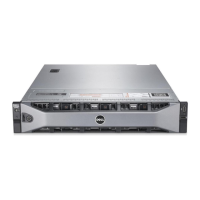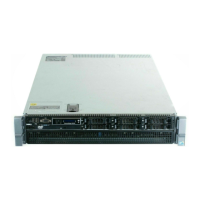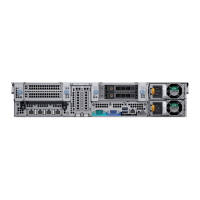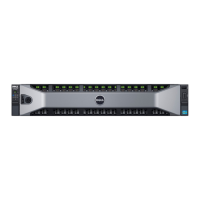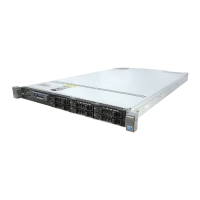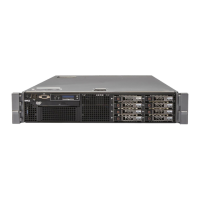Do you have a question about the Dell PowerEdge R820 and is the answer not in the manual?
Instructions on how to access and enter the system setup utility.
Overview of the main menu and screen options available in System Setup.
Configuration options and information related to the system's memory modules.
Details on processor settings, including speed, cache, and core configuration.
Configuration for setting the system's boot mode (BIOS or UEFI).
Settings to configure system profiles for performance and power management.
Options for configuring system security settings like passwords and TPM.
Guidance on setting and managing system and setup passwords for security.
Procedure to access the UEFI Boot Manager for boot option management.
Interface for setting up and configuring iDRAC parameters via UEFI.
Step-by-step guide to safely remove the Processor Expansion Module.
Step-by-step guide to safely install the Processor Expansion Module.
Information on supported memory types, configurations, and installation.
Recommended guidelines for best performance when installing memory modules.
Procedure for safely preparing and removing a hot-swap hard drive.
Procedure for safely installing a hot-swap hard drive into the system.
Information on processor installation and replacement procedures.
Step-by-step guide to safely remove a processor from its socket.
Step-by-step guide to safely install a processor into its socket.
Details on supported AC and DC power supply modules.
Instructions for safely removing an AC power supply.
Instructions for safely installing an AC power supply.
Guidelines for wiring DC power supplies, including safety precautions.
Instructions for safely removing a DC power supply.
Instructions for safely installing a DC power supply.
Instructions for safely removing the system board.
Instructions for safely installing the system board.
General safety precautions for troubleshooting system issues.
Steps to diagnose and resolve issues related to system startup failures.
Guidance for diagnosing and resolving Network Interface Controller issues.
Procedure for troubleshooting a system that has been exposed to liquid.
Steps to ensure component installation and troubleshoot a damaged system.
Procedure for reseating and troubleshooting power supply issues.
Troubleshooting steps for system cooling issues, including fans and airflow.
Diagnosing and resolving issues with system cooling fans.
Steps to diagnose and resolve system memory related problems.
Procedure for diagnosing and resolving hard drive issues.
Steps to troubleshoot issues with SAS or PERC storage controller cards.
Procedure for diagnosing and resolving issues with expansion cards.
Steps to diagnose and resolve processor-related issues.
Information on the embedded system diagnostics (ePSA) for pre-boot hardware assessment.
Procedure to launch the embedded system diagnostics program from the Lifecycle Controller.
Procedure for disabling system and setup passwords using the password jumper.
Information on system messages displayed on the monitor for possible problems.
Information on how to contact Dell for sales, technical support, and service.
Instructions on how to access and enter the system setup utility.
Overview of the main menu and screen options available in System Setup.
Configuration options and information related to the system's memory modules.
Details on processor settings, including speed, cache, and core configuration.
Configuration for setting the system's boot mode (BIOS or UEFI).
Settings to configure system profiles for performance and power management.
Options for configuring system security settings like passwords and TPM.
Guidance on setting and managing system and setup passwords for security.
Procedure to access the UEFI Boot Manager for boot option management.
Interface for setting up and configuring iDRAC parameters via UEFI.
Step-by-step guide to safely remove the Processor Expansion Module.
Step-by-step guide to safely install the Processor Expansion Module.
Information on supported memory types, configurations, and installation.
Recommended guidelines for best performance when installing memory modules.
Procedure for safely preparing and removing a hot-swap hard drive.
Procedure for safely installing a hot-swap hard drive into the system.
Information on processor installation and replacement procedures.
Step-by-step guide to safely remove a processor from its socket.
Step-by-step guide to safely install a processor into its socket.
Details on supported AC and DC power supply modules.
Instructions for safely removing an AC power supply.
Instructions for safely installing an AC power supply.
Guidelines for wiring DC power supplies, including safety precautions.
Instructions for safely removing a DC power supply.
Instructions for safely installing a DC power supply.
Instructions for safely removing the system board.
Instructions for safely installing the system board.
General safety precautions for troubleshooting system issues.
Steps to diagnose and resolve issues related to system startup failures.
Guidance for diagnosing and resolving Network Interface Controller issues.
Procedure for troubleshooting a system that has been exposed to liquid.
Steps to ensure component installation and troubleshoot a damaged system.
Procedure for reseating and troubleshooting power supply issues.
Troubleshooting steps for system cooling issues, including fans and airflow.
Diagnosing and resolving issues with system cooling fans.
Steps to diagnose and resolve system memory related problems.
Procedure for diagnosing and resolving hard drive issues.
Steps to troubleshoot issues with SAS or PERC storage controller cards.
Procedure for diagnosing and resolving issues with expansion cards.
Steps to diagnose and resolve processor-related issues.
Information on the embedded system diagnostics (ePSA) for pre-boot hardware assessment.
Procedure to launch the embedded system diagnostics program from the Lifecycle Controller.
Procedure for disabling system and setup passwords using the password jumper.
Information on system messages displayed on the monitor for possible problems.
Information on how to contact Dell for sales, technical support, and service.
| Bus type | QPI |
|---|---|
| Stepping | C2 |
| FSB Parity | No |
| Scalability | S4S |
| Processor code | SR0KU |
| Processor cache | 12 MB |
| Processor cores | 6 |
| Processor model | E5-4607 |
| System bus rate | 6.4 GT/s |
| Processor series | Intel Xeon E5-4600 |
| Processor socket | LGA 2011 (Socket R) |
| Processor threads | 12 |
| Processor codename | Sandy Bridge EP |
| Motherboard chipset | Intel C600 |
| Number of QPI links | 2 |
| Processor frequency | 2.2 GHz |
| Processor cache type | Smart Cache |
| Processor lithography | 32 nm |
| Processor manufacturer | Intel |
| Processor package size | 52.5 x 45.0 mm |
| Processor front side bus | - MHz |
| Processor operating modes | 64-bit |
| ECC supported by processor | Yes |
| Supported instruction sets | AVX |
| Thermal Design Power (TDP) | 95 W |
| Number of processors installed | 4 |
| Maximum number of PCI Express lanes | 40 |
| Memory types supported by processor | DDR3-SDRAM |
| Memory channels supported by processor | Quad |
| Memory clock speeds supported by processor | 800, 1066 MHz |
| Memory bandwidth supported by processor (max) | 34.1 GB/s |
| Maximum internal memory supported by processor | 1500 GB |
| HDD size | 2.5 \ |
| HDD speed | 15000 RPM |
| RAID levels | 0, 1, 5, 6 |
| HDD capacity | 300 GB |
| HDD interface | Serial Attached SCSI (SAS) |
| Optical drive type | - |
| Total storage capacity | 1800 GB |
| Maximum storage capacity | 16 TB |
| Memory slots | 48x DIMM |
| Internal memory | 128 GB |
| Memory clock speed | 1066 MHz |
| Maximum internal memory | 768 GB |
| Memory layout (slots x size) | 16 x 8 GB |
| Maximum graphics card memory | 256 MB |
| Graphics card | G200 |
| Graphics card family | Matrox |
| Cabling technology | 10/100/1000Base-T(X) |
| Serial ports quantity | 1 |
| USB 2.0 ports quantity | USB 2.0 ports have a data transmission speed of 480 Mbps, and are backwards compatible with USB 1.1 ports. You can connect all kinds of peripheral devices to them. |
| PCI Express x8 slots | 5 |
| PCI Express slots version | 3.0 |
| Compatible operating systems | Microsoft Windows Server 2012 Microsoft Windows Server 2008 R2 SP1, x64 (includes Hyper-V) Novell SUSE Linux Enterprise Server Red Hat Enterprise Linux Citrix XenServer VMware vSphere ESXi Red Hat Enterprise Virtualization |
| Chassis type | Rack (2U) |
| Power supply | 1100 W |
| Sustainability certificates | ENERGY STAR |
| Processor ARK ID | 64604 |
| Intel Identity Protection Technology version | 0.00 |
| Width | - mm |
|---|
